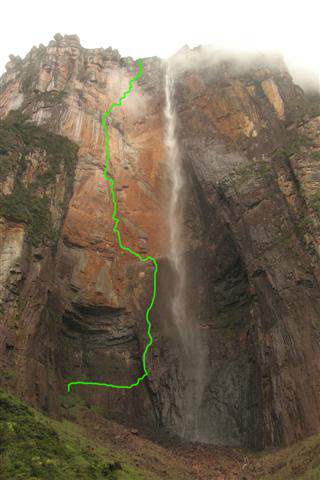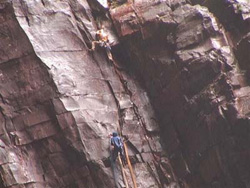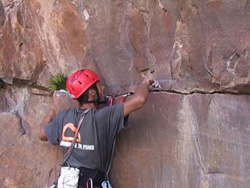Angel
Wall. Expedition to the lost world
Alexander Klenov gives an
interview to Anna Piunova, Mountain.RU
Part 1
 Country:
Venezuela
Country:
Venezuela
Wall: Angel Wall
Route: Rainbow JAMBAI
Characteristics: 1100m, E7, 6b
(Great Britain grade) or ED3, 7C + (7C + obligatoire)
Participants:
Alexander Klenov "MANARAGA-TEAM"
John Arran
Anne Arran, 34
Ivan Calderon
Miles Gibson
Ben Heason
Alfredo Rangel
“The route is unique. It has such
absolute overhanging that you can not find any where among BIG WALLs.
The plumb line from the top point up to
the bottom drifts away not less than 150 meters.
Route extent 1100m.
To tell that it is 6B grade (Russian grade)
means to tell nothing about the route.
If you look at the route line you will understand
that we climbed it not for a tick and picture in the report.
More than half of the route is a new line
that we paved.”

MR: What were the main expedition
aims?
A.Ê.: The main task for the English
climbers was not climbing all the route but clean sending all the pitches.
In other words the pitch should be climbed from the beginning up
to the end, from a belay point up to the following station, without
falls. If you fell you would repeat the pitch once again.
|

first pitches
|
MR: Every climber?
A.K.: No, of course, the leader.
The second free climbed too but if one could to climb, - the pitch considered
as valid, free.
MR: How did you organize work
on the wall?
A.K.: The basic work devolved
upon four main climbers as it had been planned: the main leaders were
Ben Heason, John Arran, Miles Gibson and I. But everyone was not lacking
in work and did his bit to the final result. If not, nobody can tell
what would be the end of our adventure?.....
A two-man team worked on the wall
one day, the next day one of them had a rest (symbolically), i.e. transferred
to haul different gear. A new fresh player joined to the remainder.
Well, and we climbed in this manner so many pitches as we could climb
for a day. Accordingly, if you climbed a pitch, you would be changed
and have a rest. Therefore, it was a lottery: what pitch would fall
to your lot. All of us came in for everything.
|

At the foot of the water-fall
|
MR: What sites did you climb?
A.K.: Å6 on-sight (I only had redpointed Å6 in England before)
and two pitches Å7, redpoint. One of the Å7 pitches I was the
second and climbed top-rope. I organized to lead the two crux pitches
at the middle of the wall but unfortunately it was not my turn to redpoint
them.
MR: What did the route ensue from
all that?
A.K.: In total 31 pitches. I
do not remember precisely its complexity: three pitches Å7, six - Å6,
the others - 4-5. Basically, Å5 and two or three pitches of Å3-Å4. There
were not less graded pitches, except for the first approach on a ledge
which we did not consider as a pitch at all.
MR: Route characteristics.
A.K.: 1100m, E7, 6b (GrB grade)
or ED3, 7C + (7C + obligatore)
MR: Total time on the Wall.
A.K.: 19 days upward, a spending
the night and a day of descent.
We had to spend the night at the
top because we reached it in the evening at about 5 pm. Miles and I
climbed the last pitches and were at the top on April 4. Two lions
and two tigers - but he is 12 years younger - interesting combination
appeared in our two-man team. Then we descended and reached the top
again with the others on April 5.
MR: Crew integration.
A.K.: The team was very strong.
It was very important because the wall was exhausting and we had a lot
of gear. Only water we hauled 350 liters.
MR: Did you use a portaledge?
A.K.: We spent the nights in
a portaledge and on the ledges. Five camps in total. I spent
14 nights on the wall: for two days longer than the others. I did not
descend to BC any more after I began to climb. First we climbed with
Ben. Then he left but I remained and continued to work with Miles.
|

The total amount of Tepui - the gigantic
sandstone plateaus in Venezuela is not counted
|
MR: Has this Wall its own feature
(in comparison with previous ones climbed by you)?
A.K.: The Wall hangs in a mysterious
way. We have carried out the unique operation on the top and counted
up all our ropes, cords, quickdraws, auxiliary slings. 1100 meters!
Then we lowered all the gear downwards from the top: that plumb landed
deviating about two hundred meters the wall's slope.
Unreal overhanging! But all time
the wall seems short because you can see only a small site of it above
yourself.
|

It is good when the strong crack comes
across
|
MR: Vertical sites were not at
all, were they?
A.K.: No, vertical sites are
present, but among this system of cornices you find the variants with
less overhanging.
In general, all the wall hangs, and
furthermore it is concave in the middle. There were two-three vertical
pitches in the beginning of the route, the others went on hanging sites.
May be the last pitch before the ridge where "jungle" began.
This "jungle" pitch seemed easy:
look, catch at the branches of trees and climb, but that vegetation
was surprising, practically without root system and thick 10-centimetric
trees did hot hold you and just got uprooted. You could not belay there,
even at steep dumose slopes. To tell the truth, such pitch was only
one, the last.
|

I am rifting the river for the first time
|
MR: What about your general impressions,
mood after the expedition?
A.K.: All of us went home pleased.
That sort of thing is quite occasional in international expeditions.
Pleased with each other and achieved result.
MR: Have you participatory action
plan for the future?
A.K.: For now just theoretical.
After such grandiose project following one need the time to mature.
For example, John needed five years to climb Angel Wall from a plan
up to its embodiment. He speaks: “For present I have no idea of worth
I want to spend five years for”.
Certainly, I have some plans, but
they are not concrete to tell about. May be to go back to Tepui or to
Pakistan to try Trango Tower or Shipton Spire (5850 m). Wait and see!
|

Our seventh participant Alfredo- the real
Indian
|
MR: Did western climbers give
a taste of their quality in international team? Pluses and minuses.
A.K.: I would like to particularly
mention that plus: they have undoubtedly higher level of climbing. In
our four-man team our climbing level was perfectly alike. But if there
is an apparent leader in a Russian team, all the same I did not hear
that someone from our climbers climbed 7Ñ on-sight.
What minuses? - Smaller experience
of wall ascents. I was practically given a free hand in the tactics
and game plan of our ascent.
In my opinion Russians have better
experience in wall climbing, rope activities, team- working, probably
due to the Russian championships.
Besides my partners had some gear
innovations, for example, protectors for ropes because hard-rock was
like sandpaper there with a lot of quartz and a sharp side could cut
a rope literally in some minutes. Therefore protectors are required.
And in general they had more varied assortment of gear: friends etc.
John and Anna have a wide experience
of ascents in Tepui. They approximately knew what to expect - water,
heat, rain. They already were ready to this.
MR: What, by the way, did you
have climbing the Wall?
A.K.: We did not use essentially bolts at belay, used only a few
bolts in bivies where we had to pitch a portaledge. In general, on all
the route we used only two pitons. The rest gear - various chocks.
Part
2 >>

